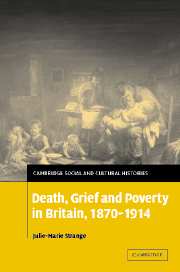Book contents
- Frontmatter
- Contents
- Acknowledgements
- List of abbreviations
- 1 Introduction: revisiting the Victorian and Edwardian celebration of death
- 2 Life, sickness and death
- 3 Caring for the corpse
- 4 The funeral
- 5 Only a pauper whom nobody owns: reassessing the pauper burial
- 6 Remembering the dead: the cemetery as a landscape for grief
- 7 Loss, memory and the management of feeling
- 8 Grieving for dead children
- 9 Epilogue: death, grief and the Great War
- Bibliography
- Index
5 - Only a pauper whom nobody owns: reassessing the pauper burial
Published online by Cambridge University Press: 05 July 2009
- Frontmatter
- Contents
- Acknowledgements
- List of abbreviations
- 1 Introduction: revisiting the Victorian and Edwardian celebration of death
- 2 Life, sickness and death
- 3 Caring for the corpse
- 4 The funeral
- 5 Only a pauper whom nobody owns: reassessing the pauper burial
- 6 Remembering the dead: the cemetery as a landscape for grief
- 7 Loss, memory and the management of feeling
- 8 Grieving for dead children
- 9 Epilogue: death, grief and the Great War
- Bibliography
- Index
Summary
The previous chapters have argued that the rites of caring for and disposing of the corpse provided forums for the expression of feeling in the immediate aftermath of death. This chapter explores the implications of burial where those rites were prohibited or curtailed: the pauper burial. Antipathy to the pauper grave is well documented. Indeed, Anne Crowther suggests that it was the most ‘familiar’ aspect of hostility to the workhouse: it signified abject poverty and stigmatised both the deceased and the bereaved. Yet for contemporaries and historians alike, the pauper burial was not only inseparable from the workhouse, but, also, from consumer culture and the language of respectability. Within the increasingly commercial society of Victorian Britain, suggests Thomas Laqueur, the pauper funeral ‘became the final stamp of failure’. In contrast, the private grave signified cultural membership: the procession to the cemetery, the occupation of public space and the participation of family, neighbours and colleagues operated as rituals of inclusion and testified to a community identity. In this sense, the ability to save money for a private grave ‘became the locus of enormous anxiety’ because the economy of the pauper burial condemned the dead to ‘dying bereft of the final signs of communal membership’.
Laqueur's argument hinges on the growth of a capitalist economy, the commercialisation of death and the punitive principles of the New Poor Law of 1834.
- Type
- Chapter
- Information
- Death, Grief and Poverty in Britain, 1870–1914 , pp. 131 - 162Publisher: Cambridge University PressPrint publication year: 2005



